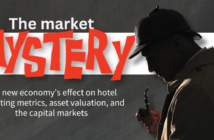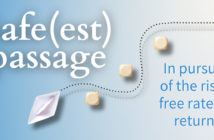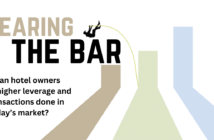by Rushi Shah
Should financing at the highest possible leverage be my goal for hotel financing? How do I know the right amount of debt to put on my property?
It’s easy for borrowers to confuse how much debt they want to pay off with how much debt their property can actually support. In an effort to wring every possible dollar out of a transaction, we’ve seen hotel owners go from broker to broker in pursuit of blue-sky leverage. The end result? Best case, someone overpromises, and after months of heartache re-trades the borrower to a lower loan amount. Worst case, the property ends up overleveraged, exposing the borrower to increased risk if cash flow declines. Subsequently, if there is even a minor ripple in the market’s economic cycle, the borrower could be left up the proverbial creek without a paddle and lose the property.
To ensure a more prudent amount of leverage, the first step is to work with an experienced investment banking professional to assess your situation and accurately diagnose how much debt your property will bear.
Your banker will look at your property’s cash flow, competitiveness and value through the lens of a lender. Lenders don’t wait for the story to unfold, they skip straight to the ending or their exit strategy from the loan. First, lenders want to know if the property’s actual cash flow, or projected cash flow once you’ve executed your business plan, will support the debt service after other expenses without any interruption in payments. Second, they validate whether the proceeds from the sale or refinance of the property would provide sufficient return of capital to cover the principal balance of their loan. Third, the lender determines if the property’s cash flow and value will enable it to be sold or successfully refinanced to a fixed-rate loan at maturity. Owners have to remember that the lenders are getting paid a low return for their debt capital, so their risk appetite is always lower than that of an equity investor. Lenders’ primary objective is capital preservation.
To answer these questions, lenders calculate key metrics that indicate if the property is already stabilized and performing at market, or if it is still in transition post construction, conversion, renovation or acquisition.
Stabilized properties will be evaluated based on historical performance that is overlaid with current conditions and expected future market trends, making the lender’s exit strategy relatively clear cut and capital options more plentiful. Signs a property is stabilized include:
Occupancy levels and average daily rates that are at par with those of competitive sets.
Expenses that are in line with benchmarks.
Limited deferred maintenance.
Appropriate levels of reserves.
Seasoned management.
Cash flow potential that is already maximized.
Transitioning properties, on the other hand, have not reached market levels and can only be assessed based on projected performance. Shorter terms and higher rates go hand-in-hand with this increased level of lender risk, and capital is more scarce. Any properties that are less than stabilized and have to rely on the projections qualify for bridge loans.
Below are the primary calculations your investment banker and lender will use to size your loan.
Net Cash Flow (NCF) or Net Operating Income (NOI)
This is your net profit before paying for any debt or any one-time capital expenses. It is calculated by subtracting expenses (including a typical 3 percent management fee) and any reserves (such as a 4 percent reserve for furniture, fixtures or other equipment (FF&E)) from your hotel’s historical revenue for stabilized properties, and 36 months projected revenue for properties still in transition.
For example, a Hampton Inn that has been open for two months is doing $50,000 per month in net operating income (NOI) but is expected to do an annual NOI of $1.2 million at a 100 percent RevPAR index and at a market NOI expense ratio of 35 percent for a typical Hampton Inn. This property can withstand a bridge loan of up to $10 million because that’s what the stabilized projections can support.
RevPar Index
This index offers lenders insight into how well your hotel is managed in terms of revenue compared to your competitive set. The definition of a stabilized property means an index is closer to 90 percent or 100 percent. On an exceptional basis, we can convince the lenders to accept projections that have over 100 percent of the RevPar index penetration.
Capitalization or Cap Rate
To calculate your property’s unleveraged value, lenders divide your NOI by your hotel’s estimated value (based on sales of comparable hotels in the same market) to arrive at a capitalization or cap rate. cap rates can also be derived using market comps that are typically derived after consulting with the investment banker’s appraisal contacts. Underwriters then apply their maximum LTV to determine the proposed loan amount. If your cash flow is already stabilized, and there is no or limited upside, then the cap rate will already reflect this and will be higher. Conversely, if there is still room to increase value, your cap rate will be lower and your hotel’s value higher.
For example, if your hotel currently produces $1 million in cash flow and is running at 80 percent RevPar index, but next year cash flow increases to $1.5 million at 100 percent of RevPar index, you can justify a 7.5 percent cap rate instead of 8 percent. The lower cap rate garners you a hotel value of $13.3 million instead of $12.5 million.
Debt Yield & LTV Requirements
Debt yield is arguably the most important metric for the lenders. Because lenders are focused on their exit strategy, your NOI is also divided by the proposed loan amount to determine what the expected rate of return on a lender’s investment would be on day one, or its debt yield. When income is less predictable, as in markets where cash flow is less stable or for flags lower on the STR chain scale, or when credit markets tighten hotel lending, lenders raise their required debt yield level. This in turn reduces how much you can borrow. Your final loan amount, however is still subject to the lender’s loan-to-value (LTV) cap which is usually 70 percent for select service hotels for a loan with senior lien.
Total Cost Basis in the Property
Often overlooked, but important to credit committees and bond market rating agencies, is the total dollars invested for construction or capital improvements since the hotel was built or acquired. This is increasingly becoming an important measure as we approach peak of an economic recovery.
These investments often trip up borrowers who mistakenly expect the value of their hotel to exactly mirror the amount of money they have put into the asset. This misconception is like installing a $50,000 chandelier imported from Italy in your dining room and expecting your home’s value to immediately increase by $50,000.
There are ways to effectively close the gap, however some are more palatable than others. We had a client with a brand new full-service hotel with a good flag in a good market looking to refinance his construction loan. Unfortunately, the developer had gone over budget due to construction delays, general contractor mismanagement and excessive customizations beyond the brand’s requirements. The borrower wanted to refinance everything he had invested, but at the end of the day the hotel’s value wasn’t there yet to commensurate with the market.
In order to cover his total cost basis, the borrower faced the choice of investing more of his own capital, raising additional common equity from his partners or bridging the gap with a high-priced, mezzanine loan subordinate to the senior debt. Instead, by negotiating with the current lender to hold back funds as preferred equity until the hotel stabilizes, we were able to refinance the client to a 24-month, interest-only bridge loan. Once the property is stabilized, we will leverage our capital source relationships to refinance the bridge loan to non-recourse permanent debt, enable the borrower to recoup his investment cost as cash out, and take out the current lender at the same time.
In some situations, mezzanine debt can be a viable solution. However, your investment banker should first exhaust more favorable options, as rates for hotels range between 10 percent and 12 percent compared to 4.5 percent to 6.5 percent for senior debt, and lenders typically only write check sizes for $3 million and up.
Are my property’s metrics absolute? Or is there room to negotiate with lenders to increase leverage?
Bottom line, when determining value and leverage, you must be realistic. No one is going to give you $110 for a $100 bill. Structuring a commercial real estate loan transaction, however, is both an art and a science. By leveraging long-time lender relationships, structuring around pain points, identifying and alleviating any anomalies and inconsistencies in your or your competitive data, augmenting current and future market insights to shape projections, and successfully demonstrating your ability to execute your business plan, a skilled investment banking professional can be both the sculptor and fulcrum of certainty of execution and optimal results.




